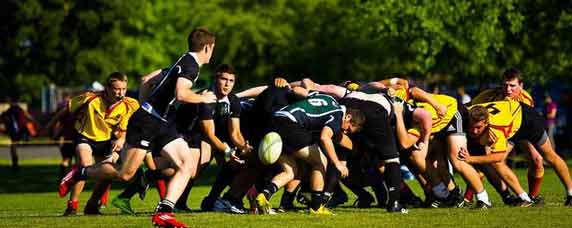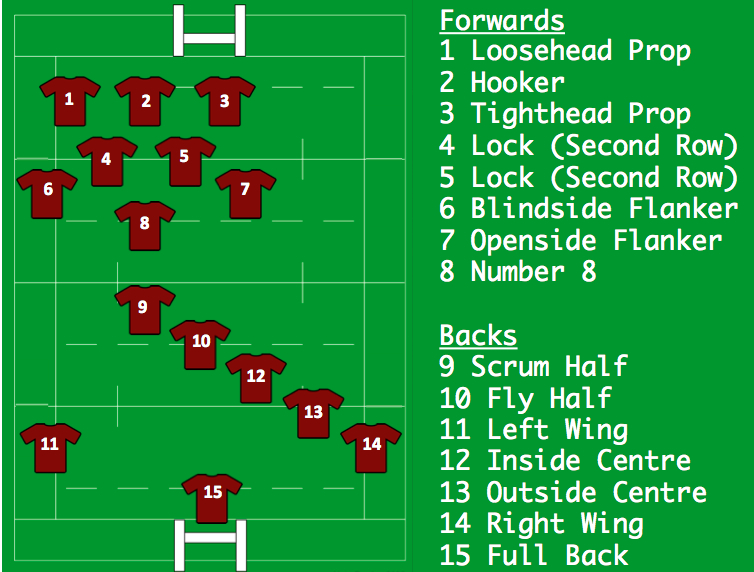

Rugby 101-Part II
HS / CLUB RUGBYNorCal EditionSac-Joaquin SectionSac/Joaquin Edition February 19, 2017 SportStars 0

How To Play; How To Score; And What’s A Scrum?
Last month, we discussed the history of the sport of Rugby, the very basics on what the sport is and where it is played. This month, we explain HOW you actually play the game and what some of the laws of the game are.
STARTING THE GAME — Just as in American football, rugby begins with a kickoff to the opponent from mid-field. Provided that the ball travels beyond the 10-meter line, any player from either team may gain possession of the ball.
MOVING OR ADVANCING THE BALL — Rugby, like soccer, is continuous. There is no blocking in rugby. The person with the ball leads the attack. There are only three ways to move the ball in rugby: a player may carry (run), pass or kick the ball. When a player is tackled or the ball hits the ground, play is not stopped unless there is some sort of infraction or the ball is considered dead or buried in a ruck or maul (explained later).
Running: When running the ball, players may continue to run until they are tackled, step out of bounds or run beyond the goal line. Players run the ball to advance toward the opponent’s goal line.
Passing: The ball may be passed to any player. However, it may only be passed laterally or backward, never forward. Players pass the ball to an open teammate to keep it in play and further advance it.
Kicking: Any player may kick the ball forward at any time. Once the ball is kicked, players of either team, regardless of whether or not the ball hits the ground, may gain possession. Players typically kick the ball to a teammate in an effort to advance it or to the opposing team to obtain relief from poor field position.
SCORING — There are four ways for a team to score points in rugby:
Try: Five points are awarded to a team for touching the ball down in the other team’s in-goal area. This is much like a touchdown in American football but requires the ball actually be grounded.
Conversion: Following a try, two points are awarded for a successful kick through the goal posts. The attempt is taken on a line, at least 10 meters from the try line, straight out from the point where the ball was touched down. This is like an extra point in American football, but often at an extreme angle to the goalposts.
 Penalty Kick: Following a major law violation, the attacking team, if in range, has the option to “kick for points.” Three points are awarded for a successful penalty kick. The kick must be from the point of the penalty or anywhere on a line straight behind that point. The ball is considered live and can be played if the kick fails.
Penalty Kick: Following a major law violation, the attacking team, if in range, has the option to “kick for points.” Three points are awarded for a successful penalty kick. The kick must be from the point of the penalty or anywhere on a line straight behind that point. The ball is considered live and can be played if the kick fails.
Drop Goal: Three points are awarded for a successful drop kick. A drop kick may be taken from anywhere on the field during play. A drop goal is similar to a field goal in football; however, in rugby the kick is made during the course of normal play. The ball is alive if the kick fails.
RESTARTING PLAY — There are three methods of restarting play following a stoppage caused by either the ball going out of bounds or because of an infraction of the laws.
Line-Out: If the ball goes out of bounds, it is restarted with a line-out. Except for a penalty kick out of bounds, the team that kicks or runs the ball out of bounds turns over the possession to the other team. Both teams form a line perpendicular to the touchline and one-meter (three feet) apart from one another. A team taking possession calls a play and throws the ball in the air in a straight line between the two lines. Players of each team may be supported in the air by their teammates to gain possession of the ball. This is similar to a jump ball in basketball.
Scrum: This method is used to restart the game after the referee has whistled a minor law violation. A bound group of players from each team (the forward pack) form a “tunnel” with the opposition. The offensive team’s Scrumhalf puts the ball into the tunnel by rolling it in where the Hooker tries to drag the ball back (hook it) with his foot to his teammates, while each team pushes forward to try and gain an advantage. The ball works its way back through the forwards and then the Scrumhalf retrieves the ball and generally passes it to the backline.
Penalty Play: After a major violation called by the referee, a team can be awarded a penalty kick. The offending team must retreat 10 meters. The awarded team can quickly tap the ball through the mark set by the referee and run it, or they can kick the ball directly out and be awarded the line-out where the ball crosses the sideline.
TACKLES, RUCKS AND MAULS — A player tackled to the ground must make the ball available immediately so play can continue. Supporting players from both teams converge over the ball on the ground, binding with each other in an attempt to push the opposing players backwards in a manner similar to a scrum. This situation is known as a ruck. The ball may not be picked up by any player, until the it emerges out of the back of the ruck. A maul is formed with a similar gathering of players, except the player in possession of the ball is simply held up, and not tackled. The maul ends when the ball emerges.
If you have any questions in the meantime, or would like more information on how to get involved yourself; contact Mark Carney at [email protected] or visit www.rugbynorcal.org.
[sam_pro id=”1_8″ codes=”true”]









No comments so far.
Be first to leave comment below.